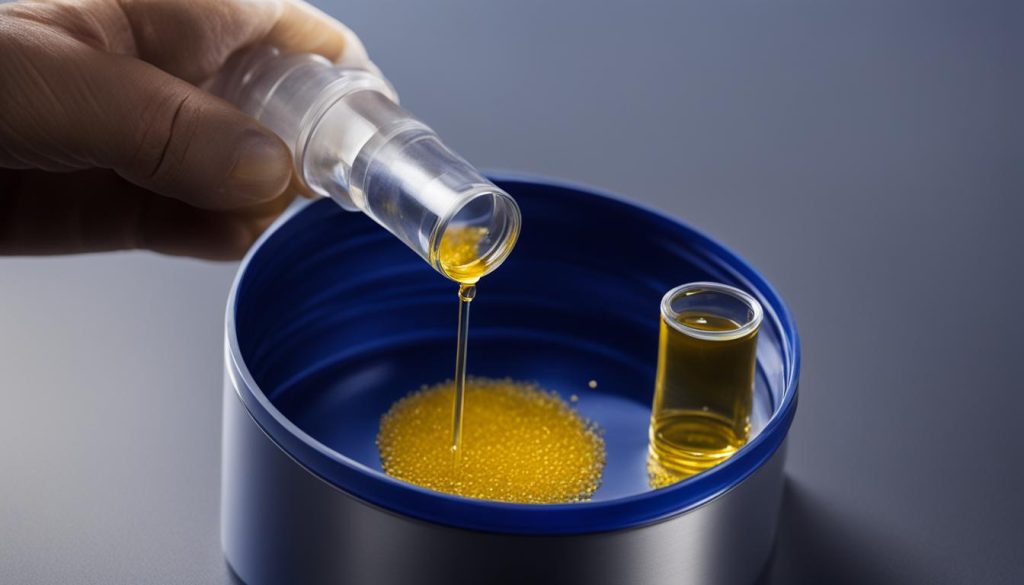
High metabolism can potentially influence the results of a drug test. The speed at which your body metabolizes substances can affect how long certain drugs stay in your system, particularly in urine samples. Metabolism refers to the biochemical processes that occur in your body to break down substances, such as drugs, and eliminate them. Understanding the relationship between metabolism and drug test results can provide insight into how long drugs may be detectable in urine samples.
Key Takeaways:
- High metabolism can impact drug test results, especially in urine samples.
- The speed of metabolism affects how long drugs stay detectable in the system.
- Metabolism refers to the body’s processes of breaking down and eliminating substances.
- Understanding the relationship between metabolism and drug tests can provide insights into detection windows.
- Factors such as genetics, body fat percentage, and frequency of drug use can also affect drug test results.
Factors Affecting Drug Detection in Urine
When it comes to drug detection in urine, there are several key factors that can influence the results. Understanding these factors is crucial for accurately interpreting urine sample results and gaining insights into drug detection processes. Here, we explore the various elements that contribute to drug detection in urine, including body metabolism, genetics, and body fat percentage.
The Role of Body Metabolism
Body metabolism plays a significant role in drug detection in urine samples. Metabolism refers to the biochemical processes that occur in the body to break down substances, such as drugs, and eliminate them. Individuals with higher metabolic rates tend to eliminate drugs more quickly than those with slower metabolisms. This means that drugs may be detectable for shorter periods in the urine of people with high metabolism.
The Influence of Genetics
Genetics is another factor that can impact drug detection in urine. Certain genetic variations can accelerate the metabolism of drugs, resulting in a shorter detection window. These genetic variations can affect the production of specific enzymes responsible for drug metabolism. Understanding the role of genetics can provide insights into individual differences in drug metabolism and elimination.
The Impact of Body Fat Percentage
Body fat percentage can also affect drug detection in urine. THC, the active compound in cannabis, for example, is fat-soluble and can bind to fat molecules in the body. This can prolong the presence of THC in the system, leading to a longer detection window. Individuals with higher body fat percentages may metabolize drugs more slowly, resulting in an extended period of detectability in urine samples.
| Factors Affecting Drug Detection in Urine | Impact |
|---|---|
| Body Metabolism | Higher metabolism leads to shorter detection window |
| Genetics | Certain genetic variations can accelerate drug metabolism |
| Body Fat Percentage | Higher body fat can prolong drug detectability |
By considering these factors influencing drug detection in urine, we can gain a better understanding of how different individuals may experience variations in drug test outcomes. It is important to note that drug detection in urine is a complex process influenced by multiple factors beyond those discussed here. Therefore, it is always advisable to consult professionals familiar with the specific requirements and limitations of drug testing.
Types of Drug Tests and Detection Windows
When it comes to drug testing, different types of tests have varying detection windows. Understanding these detection windows is crucial for accurately interpreting drug test results. Here, we provide an overview of the various drug tests commonly used and their respective detection windows.
Urine Tests
Urine tests are one of the most frequently used methods for detecting drugs in the system. The detection window for urine tests can range from 3 to 30 days, depending on the substance being tested for. For example, marijuana can typically be detected in urine for 1 to 30 days after use. It’s important to note that the length of time drugs remain detectable in urine can be influenced by various factors, such as the amount and frequency of drug use, metabolism, and individual differences.
Blood Tests
Blood tests are another method used for drug testing, particularly in cases where recent drug use needs to be detected. The detection window for drugs in blood is relatively short, typically ranging from a few hours to a maximum of 24 hours, depending on the substance. Blood tests are often used in situations where immediate detection of drug use is necessary, such as in cases of suspected impairment or under the influence.
Saliva Tests
Saliva tests are becoming increasingly popular due to their ease of use and non-invasive nature. The detection window for drugs in saliva can range from 24 to 72 hours, depending on the substance. Saliva tests are often used in workplace drug testing programs or in other situations where recent drug use needs to be detected. It’s important to note that the detection window for drugs in saliva may vary depending on factors such as the type of drug and individual differences.
Hair Tests
Hair tests are the most sensitive type of drug test and have the longest detection window. The detection window for drugs in hair can extend up to 90 days, making it an effective method for detecting long-term drug use. However, it’s important to note that hair tests are unable to detect recent drug use. Instead, they provide a historical overview of drug use over a longer period of time.
Table: Comparison of Drug Detection Windows by Test Type
| Drug Test Type | Detection Window |
|---|---|
| Urine Test | 3 to 30 days (varies by substance) |
| Blood Test | A few hours to 24 hours |
| Saliva Test | 24 to 72 hours |
| Hair Test | Up to 90 days |
Table: Comparison of drug detection windows by test type.
Cannabis and Detection in Urine
When it comes to drug testing, cannabis is a substance that can pose challenges in terms of detection. THC, the active compound in cannabis, can be detected in urine samples for varying periods of time. The detection window depends on several factors, including the frequency and duration of cannabis use.
For occasional cannabis users, the detection window in urine samples is typically around 3 days. However, for chronic users who consume cannabis on a regular basis, the detection window can be extended to up to 30 days. This is because THC can be stored in fat cells and released slowly over time, resulting in a longer detection period.
It’s important to note that the potency of the cannabis consumed can also affect the detection window. Higher potency cannabis products may contain higher levels of THC, which can take longer to metabolize and eliminate from the body. Therefore, individuals who consume highly potent cannabis may have a longer detection window compared to those who consume lower potency products.
Factors Affecting Cannabis Detection in Urine
The detection of cannabis in urine samples can also be influenced by factors such as metabolism and hydration levels. Individuals with higher metabolic rates may eliminate THC more quickly from their bodies, resulting in a shorter detection window. Conversely, individuals with slower metabolisms may have a longer detection window.
Hydration levels can also play a role in cannabis detection. Drinking plenty of water can help flush out THC and its metabolites from the body, potentially reducing the detection window. On the other hand, dehydration can lead to a higher concentration of THC in urine, prolonging the detection period.
| Factors | Impact on Cannabis Detection in Urine |
|---|---|
| Cannabis potency | Higher potency cannabis may result in a longer detection window. |
| Frequency and duration of use | Chronic users may have a longer detection window compared to occasional users. |
| Metabolism | Individuals with higher metabolic rates may have a shorter detection window. |
| Hydration levels | Staying hydrated can potentially reduce the detection window. |
Understanding the factors that influence cannabis detection in urine samples is crucial for interpreting drug test results accurately. It’s important for individuals undergoing drug testing to be aware of these factors and take them into consideration.
High Metabolism and Drug Test Elimination
In our previous sections, we discussed the influence of high metabolism on drug test results and the factors that can affect drug detection in urine samples. Now, let’s dive deeper into how high metabolism can impact the elimination of drugs from the body, particularly THC, the active compound in cannabis.
Individuals with high metabolisms tend to eliminate drugs, including THC, from their systems more quickly than those with slower metabolisms. Metabolism plays a crucial role in breaking down drugs and their metabolites, which are eliminated through urine and other bodily functions. A high metabolism can result in a shorter detection window due to the faster elimination of drugs from the body.
However, it is important to note that individual metabolism rates can vary, and other factors, such as body fat percentage, can also impact drug test elimination. Body fat can affect drug detection because THC is fat-soluble and can bind to fat molecules, prolonging its presence in the body. Individuals with higher body fat percentages may metabolize drugs more slowly, leading to a longer detection window.
To summarize, individuals with high metabolisms have an advantage when it comes to drug test elimination, as their bodies can break down and eliminate drugs more quickly. However, metabolism is just one piece of the puzzle, and other factors, such as body fat percentage, also play a role in drug test results. Understanding these factors can help interpret drug test outcomes more accurately and account for individual variations in drug metabolism and elimination.

| Key Points | Summary |
|---|---|
| High Metabolism | Individuals with high metabolisms eliminate drugs more quickly from their systems. |
| Body Fat Percentage | Higher body fat percentages can prolong the detection window as THC can bind to fat molecules. |
| Interpreting Test Results | Understanding the relationship between metabolism and drug test outcomes is crucial for accurately interpreting test results. |
Impact of Body Fat on Drug Detection
Body fat percentage can be a significant factor in drug detection in urine samples. THC, the psychoactive compound in cannabis, is fat-soluble and can bind to fat molecules in the body, prolonging its presence. Individuals with higher body fat concentrations may metabolize drugs more slowly, leading to an extended detection window. Age and gender can also play a role, as they can be related to body fat percentage or metabolic rates.
To better understand the impact of body fat on drug detection, we can examine the following factors:
- Body fat percentage: Individuals with higher body fat percentages may have an increased risk of prolonged drug detection in urine samples.
- Metabolism: While metabolism can vary among individuals, higher body fat percentages may be associated with slower drug metabolism, contributing to longer detection windows.
- Age and gender: Age and gender can influence body fat percentage, with higher percentages often seen in older individuals and females. These factors can potentially impact drug detection in urine samples.
Understanding the potential impact of body fat on drug detection is essential, especially for individuals with higher body fat percentages. It is important to consider these factors when interpreting drug test results and recognizing the potential variations in drug metabolism and elimination.

Genetics and Drug Test Results
Genetics play a significant role in determining drug test results, particularly when it comes to the detection of substances like marijuana in urine samples. Variations in specific enzymes can accelerate the metabolism and elimination of drugs, leading to a shorter detection window. The concentration of these enzymes in the body is often an inherited trait, meaning individuals with certain genetic variations may eliminate drugs from their systems more quickly.
A comprehensive understanding of the influence of genetics on drug test results can provide valuable insights into individual differences in drug metabolism. By considering genetic factors, we can better interpret test outcomes and account for variations in drug detection windows. It is important to note that genetics is just one of many factors that can impact drug test results, and results should always be interpreted in conjunction with other relevant factors.
| Genetic Factor | Impact on Drug Test Results |
|---|---|
| Enzyme Variants | Accelerate drug metabolism and elimination, leading to shorter detection windows. |
| Concentration of Enzymes | The concentration of enzymes responsible for drug metabolism can vary among individuals, affecting drug test results. |
| Inherited Traits | Genetic variations that influence drug metabolism are often inherited, contributing to individual differences in drug test outcomes. |
| Interplay with other Factors | Genetics should be considered alongside other factors, such as drug consumption, frequency of use, and body fat percentage, for a comprehensive understanding of drug test results. |
Understanding the role of genetics in drug test results can assist in accurately interpreting test outcomes and considering individual variations in drug metabolism. By examining genetic factors alongside other relevant factors, we can gain a more comprehensive understanding of drug test results and their implications.
Factors Influencing Drug Detection in Urine
When it comes to drug detection in urine samples, several factors come into play. The amount of drugs consumed, the frequency of use, metabolism, genetics, and body fat percentage all have an impact on the length of time drugs can be detected. Let’s take a closer look at each of these factors.
Amount and Frequency of Drug Use
The more drugs a person consumes and the more frequently they use them, the longer the detection window becomes. This means that individuals who use drugs in larger quantities or on a regular basis may have a longer period during which the drugs are detectable in their urine.
Metabolism
Metabolism plays a crucial role in drug detection. Individuals with high metabolisms tend to eliminate drugs more quickly from their bodies, resulting in shorter detection windows. On the other hand, those with slower metabolisms may take longer to eliminate drugs, leading to longer detection windows.
Genetics
Genetics can also influence drug detection in urine samples. Certain genetic variations can affect how quickly drugs are metabolized and eliminated from the body. Individuals with genetic variants that accelerate drug metabolism may have shorter detection windows, while those without these variants may have longer detection windows.
Body Fat Percentage
Body fat percentage can impact drug detection as well. THC, the active compound in cannabis, is fat-soluble, meaning it can be stored in fat cells. Individuals with higher body fat percentages may metabolize drugs more slowly, resulting in a longer detection window for drug tests.
Overall, understanding these factors is essential in interpreting drug test results accurately. By considering the amount and frequency of drug use, metabolism, genetics, and body fat percentage, we can gain insights into how long drugs may remain detectable in urine samples.

Understanding Drug Test Detection Windows
When it comes to drug tests, understanding the detection window is crucial for accurate and meaningful results. Different types of drug tests have specific detection windows that determine how long drugs can be detected in urine samples. Let’s take a closer look at the detection windows for various drug tests:
Urine Tests
Urine tests are the most commonly used method for drug testing. They can detect drugs for different periods, ranging from 3 to 30 days, depending on the substance. This detection window is influenced by various factors such as the drug consumed, frequency of use, and individual metabolism rates. It’s important to note that the detection window does not indicate impairment or current drug use but rather the presence of drugs in the system.
Blood Tests
Blood tests have a much shorter detection window compared to urine tests. They can reliably detect drugs for only a few hours after use. This makes blood tests suitable for determining recent drug use or impairment.
Saliva Tests
Saliva tests can detect drugs for up to 72 hours after use. They are often used in settings where immediate drug use needs to be determined, such as roadside drug testing. Saliva tests are less invasive and provide quicker results compared to urine or blood tests.
Hair Tests
Hair tests have the longest detection window of all drug tests. They can detect drugs, including THC, for up to 90 days after use. Hair tests are highly sensitive and can provide a historical record of drug use. They are often used in situations where a detailed drug use history is required, such as pre-employment screening.
Understanding the detection windows of different drug tests is essential for accurate interpretation of test results. It allows us to consider the timeframe in which drugs can be detected and provides insights into an individual’s drug use history. However, it’s important to remember that drug test results should always be evaluated in conjunction with other factors, such as observed behavior and additional testing if necessary, to make informed decisions.
Impact of Cannabis Use on Drug Test Results
Cannabis use can have a significant impact on drug test results, particularly in urine samples. THC, the compound responsible for the euphoric effects of marijuana, can remain detectable in urine for 1 to 30 days after use, depending on various factors. The amount and frequency of cannabis use, as well as individual metabolism rates, can influence how long THC stays in the system. Chronic users may have longer detection windows compared to occasional users. It is crucial to consider the potential impact of cannabis use on drug test results, especially in settings where drug testing is required.
When it comes to drug tests, cannabis use is a key factor to consider. The detection window for THC in urine can vary depending on the frequency and duration of use. As THC is metabolized by the body, its metabolites are eliminated through urine. This process takes time, and the longer THC remains in the system, the longer it can be detected in a drug test.
| Type of User | Detection Window |
|---|---|
| Occasional User | 1-3 days |
| Frequent User | 10-30 days |
| Chronic User | 30+ days |
It’s important to note that these detection windows are approximate and can vary depending on individual factors such as metabolism, body fat percentage, and the potency of the cannabis consumed. Regular cannabis users may have a higher likelihood of THC being detected in their system for a longer period of time compared to occasional users.
Factors Affecting Cannabis Detection
Several factors can influence the detection of cannabis in drug tests. These include:
- Frequency of use: The more frequently cannabis is used, the longer it may take for THC to be completely eliminated from the body.
- Amount consumed: Higher doses of cannabis can result in a longer detection window as more THC is present in the body.
- Metabolism: Individuals with faster metabolisms may eliminate THC more quickly, leading to a shorter detection window.
- Body fat percentage: THC is fat-soluble, meaning it can be stored in the body’s fat cells. Individuals with higher body fat percentages may have a longer detection window.
Understanding the impact of cannabis use on drug test results is crucial for individuals who may be subject to drug testing, as well as employers and organizations that conduct drug tests. It’s important to consider the specific requirements and policies of each drug testing program and ensure informed decision-making based on accurate and reliable information.
The Relationship Between Metabolism and Drug Test Outcomes
Metabolism plays a vital role in determining the outcome of drug tests, particularly in urine samples. The speed at which the body metabolizes drugs can have a significant impact on how long substances, such as THC, remain detectable in the system. Individuals with high metabolic rates tend to eliminate drugs more quickly, resulting in shorter detection windows.
Metabolism is responsible for breaking down drugs and their metabolites, which are then eliminated through urine and other bodily functions. When it comes to drug testing, a high metabolism can lead to a shorter detection window, as drugs are processed and eliminated from the body at a faster rate. This can be advantageous for individuals who may have recently used drugs and need to pass a drug test.
However, it is important to note that metabolism is not the sole factor that determines drug test outcomes. Other factors, such as the amount and frequency of drug use, genetics, and body fat percentage, can also influence how long drugs remain detectable in urine samples. Therefore, while high metabolism can contribute to shorter detection windows, it is essential to consider these other factors when interpreting drug test results.
| Factors | Influence on Drug Test Outcomes |
|---|---|
| Metabolism | High metabolism can lead to shorter detection windows as drugs are eliminated more quickly. |
| Amount and Frequency of Drug Use | Higher drug consumption and more frequent use can extend the detection window. |
| Genetics | Specific genetic variations can accelerate drug elimination, resulting in shorter detection windows. |
| Body Fat Percentage | Higher body fat percentage can prolong drug detection as THC is fat-soluble and can be stored in fat cells. |
Understanding the relationship between metabolism and drug test outcomes is crucial for accurately interpreting test results and considering individual variations in drug metabolism and elimination. While high metabolism can contribute to shorter detection windows, it is essential to consider all relevant factors and consult with professionals when interpreting drug test results.
Conclusion
In conclusion, the results of a drug test can be influenced by an individual’s metabolism, especially when it comes to urine samples. A high metabolism can lead to a shorter detection window, as drugs are eliminated more quickly from the body. However, it’s important to consider other factors such as the amount and frequency of drug use, genetics, and body fat percentage, as they can also affect drug test results.
Understanding the relationship between metabolism and drug test outcomes is crucial for accurately interpreting test results. It allows us to recognize the individual variations in drug metabolism and elimination, providing valuable insights into the detection of drugs in urine samples. By considering these factors, we can better understand how long drugs may remain detectable and make informed decisions based on the results.
We should remember that drug test results do not necessarily indicate impairment or current drug use. The tests only detect the presence of drugs or their metabolites in the system. As such, it’s essential to interpret the results within the appropriate context and consider the unique characteristics of each individual.
FAQ
Can high metabolism influence drug test results?
Yes, high metabolism can potentially influence drug test results, particularly in urine samples. The speed at which your body metabolizes substances can affect how long certain drugs stay detectable in your system.
What factors can affect drug detection in urine?
Several factors can influence drug detection in urine, including the amount of drugs consumed, genetics, frequency of drug use, body fat percentage, and metabolism.
What are the different types of drug tests and their detection windows?
There are various types of drug tests, including urine, blood, saliva, and hair tests. Urine tests can detect drugs for 3 to 30 days, blood tests for 3 to 4 hours, saliva tests for 24 to 72 hours, and hair tests for up to 90 days.
How long can cannabis be detected in urine?
THC, the active compound in cannabis, can be detected in urine for 1 to 30 days after use, depending on factors such as the amount consumed, frequency of use, and individual metabolism rates.
Does having a high metabolism affect drug test elimination?
Individuals with high metabolisms tend to eliminate drugs, including THC, from their systems more quickly than those with slower metabolisms, potentially resulting in a shorter detection window.
Can body fat percentage impact drug detection in urine samples?
Yes, body fat percentage can influence drug detection in urine samples. THC, being fat-soluble, can bind to fat molecules and stay in the body longer. Individuals with higher body fat percentages may metabolize drugs more slowly, leading to an extended detection window.
How do genetics affect drug test results?
Genetics can play a role in drug test results, particularly in relation to how long drugs stay detectable in urine samples. Variants of certain enzymes can accelerate the elimination of drugs in some individuals, resulting in a shorter detection window.
What are the factors that influence drug detection in urine?
Factors that can influence drug detection in urine include the amount and frequency of drug use, metabolism, genetics, and body fat percentage.
How can I understand drug test detection windows?
Different types of drug tests have specific detection windows, which determine how long drugs can be detected in urine samples. Understanding the detection windows of different drug tests is essential for accurately interpreting test results.
Does cannabis use affect drug test results?
Yes, cannabis use can have a significant impact on drug test results, particularly in urine samples. The detection window for THC can vary based on the frequency and duration of cannabis use.
What is the relationship between metabolism and drug test outcomes?
Metabolism plays a vital role in drug test outcomes, particularly in urine samples. Individuals with high metabolic rates tend to eliminate drugs more quickly, resulting in shorter detection windows.
















